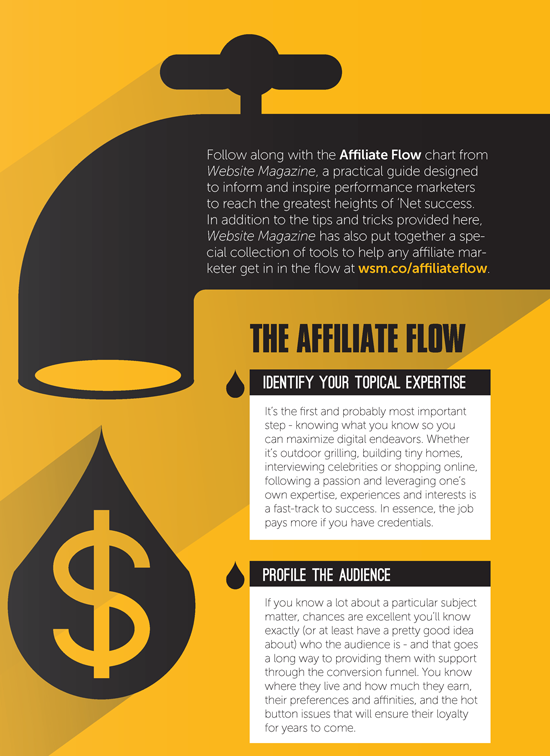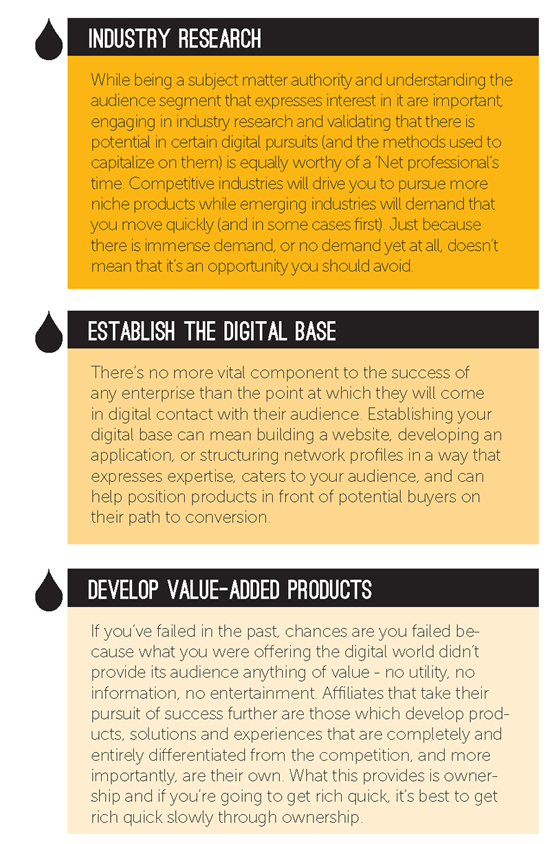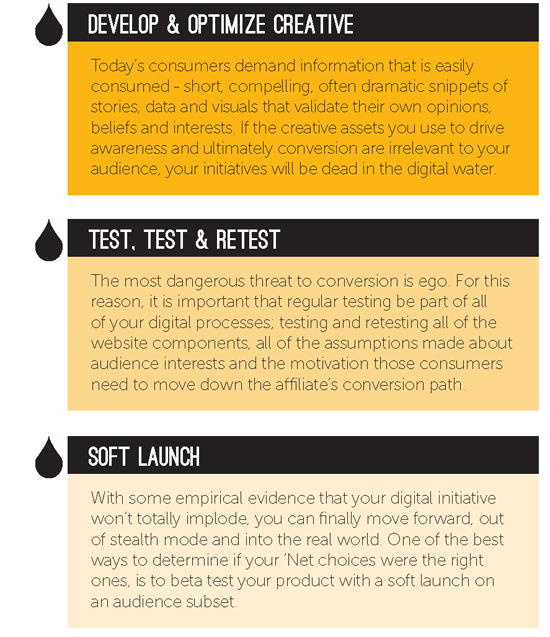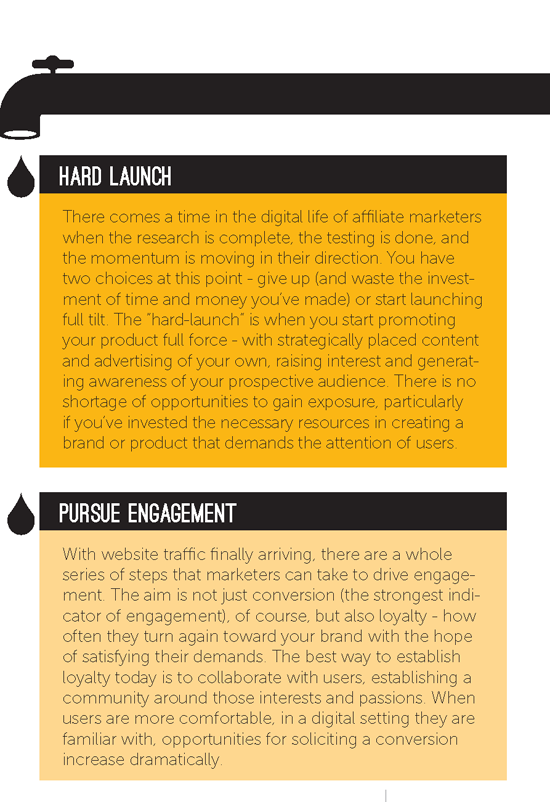The Affiliate Marketing Flow

When the Web was in its digital infancy, few knew at the time how profoundly important it would be to global commerce in the years to come. Well, that's not entirely true - many did and have made their mark on the 'Net in a very big way.
While affiliate marketing is still very much alive, well and growing (affiliate marketing spend is expected to reach $4.5 billion annually in 2016 according to Forrester), advertisers are sometimes tentative to engage in an initiative of this digital variety due not just to its complexities, but also because of its poor (and often deserved) reputation.
Affiliate Ups & Downs
Back in 2013, Shawn Hogan and Brian Dunning both became multi-millionaires by exploiting eBay's affiliate marketing program. The pair developed and subsequently dropped a cookie on a user's computer, falsely crediting their affiliate accounts for whenever those users purchased something from eBay in the future. The tactic resulted in Hogan and Dunning amassing a whopping total of $28 million between 2005 and 2007. Eventually, however, the digital ax fell and both affiliates were sent to federal prison for their approach and tactics. For every Hogan and Dunning (which are, granted, at the extreme and exemplify why affiliate marketing is avoided by some advertisers), there are instances which illustrate how lucrative and effective these initiatives are for both advertisers and affiliates.
Membership-based online shopping club Jet.com, for example, ran a contest in late 2014 to get more users signed up for its "Insiders" program, which entitled them to free trials and perks - a common tactic today employed by startups and some savvy advertisers. To make the program appealing to potential referrers (affiliates), the company offered 100,000 shares of Jet stock to the individual who could drive the most referrals to its Insider program. Affiliates joined in droves, including Eric Martin.
With just a few weeks from the close of the contest, Martin used his business savvy and his familiarity with the performance space (using reward-based advertising sites like Swagbucks and Gifthulk) to catapult his way to the top of the referrer leaderboard. Martin spent $18,000 promoting the offer and ended the contest with 8,167 referrals. If Jet manages to go public and capitalize on the pre-launch buzz it generated with the help of Martin and other "super-affiliates," a few weeks of work for Martin could ultimately result in a hefty payday between $10 and $20 million.
Those just getting started however - as well as those struggling to generate any revenue at all from their digital properties and broader 'Net initiatives - desperately need a practical guide to making "get rich quick" actually happen. They will need insights into the most effective platforms for developing, managing and optimizing a Web experience and the available solutions for assisting consumers down the parallel paths of conversion and loyalty.
Of course, it doesn't hurt to know a little about the current state of the performance marketing ecosystem (the challenges and opportunities) or the actual tactics that are helping affiliates (and the advertisers/brands they represent) generate attention and activity and leave their own virtual mark on the Web. In this month's edition of Website Magazine, you get both.
Mastering the Affiliate Flow (Every Day)
What most fail to understand about the practice of affiliate marketing is that, in many ways, it's really no different than digital marketing of any other sort.
Affiliate marketers contribute to a sale in much the same manner that in-house marketers do but it's not a direct sale in many instances, rather an indirect one - and, of course, you are earning only a percentage of the sale price (typically a flat-rate fee or a percentage-based commission) for the hard work being put in. The thing is, affiliate/performance marketing is vastly different than in years past - it's faster, consumers are more demanding (having higher expectations in general) and the models for earning are changing along with the expectations of advertisers (those that pay the digital bills). It's almost enough to make affiliate marketing seem impossible.
In this month's Website Magazine, however, readers are exposed to both a high-level overview of trends influencing and impacting the 'Net today, in relation to the practice of affiliate marketing, and are provided with some practical tactics that can be used to turn a profit (and quickly).
Know Your Audience
Put yourself in the virtual shoes of today's Web users and it might be surprising just how overwhelmed they may be as they are marketed to at every digital twist and turn of their online experience.
What 'Net users today are increasingly demanding, however, is a meaningful conversation within a relevant journey to a met objective. Marketers (affiliate marketers in particular), however, often create prepackaged experiences - but that may not be the optimal approach. A better way may just be to foster collaboration, focus on developing closer relationships and encouraging influence over impressions. Affiliate marketers today must be able to integrate social data into their personalization capabilities and build individualized experiences. The availability of marketing automation solutions provides the best opportunity to do so currently.
While it might seem like an over-the-top approach for many traditional affiliates, marketing automation solutions provide the capability for affiliates (or any digital business) to develop a detailed history of their users, marketing and remarketing to them based on their particular needs and interests. If you are already using these incredibly powerful systems (many of which you can find in Website Magazine's "Master List of Marketing Automation Tools") the time is now to take that initiative to the next level. Explore four "next-level" marketing automation techniques, as featured in a recent issue of Website Magazine, at and you'll be better prepared than ever to market to today's consumer.
For affiliate marketers, getting ahead means changing with your audience - and today's digital users are intolerant of anything that doesn't meet their expectations. With marketing automation solutions in place, affiliates can focus in on selecting the offers that have the greatest likelihood of conversion on their audience, and the advertisers and networks that provided them.
Attribution is Evolving
Affiliates most often promote offers with the highest commissions, but as any savvy performance marketer can tell you, there are other (some would argue more important) variables that should come in to play. Increasingly, it's coming down to how affiliates are rewarded for their efforts (and what those efforts might be).
Advertisers are struggling (and have long struggled) to make sure they credit the right sources of conversion and they are turning to multi-touch attribution in droves to do so.
Multi-touch attribution (MTA) is essentially the practice of allocating a proportional amount of credit to promotional efforts, across channels, which lead to the desired customer action. MTA is, in many ways, still developing, and the approach will mature in the coming years (or, at least, start to gain popular acceptance). In order to take full advantage of this method, advertisers and affiliates need to understand that there are several different ways to attribute value to customer interactions, or "touches":
Even - A basic model where all touches receive credit equally. This model is typically used when no one particular interaction is known to convert customers and the goal is ongoing marketing engagement.
Time Decay - Most credit is given to the individual touch that created the desired outcome (such as a sale), with declining credit for less recent interactions. This model is particularly useful for companies with very short sales cycles.
U-Shaped/Position - In this multi-touch attribution model, 40 percent credit is given to the fi rst and last touches, with the remaining 20 percent divided among interactions in the middle. The U-shaped model is best for advertisers seeking to drive awareness and action and is ideal for those with longer sales cycles.
Custom - In this model, advertisers determine the credit to be given for each "touch," dependent on product knowledge, customer base, and sales funnel based on factors such as cost, time or effort.
The Web, however, changes in real-time. As a result, advertisers are turning to solutions that provide them with insights into the complexity of various networks and the activity that results from their own, and their affiliates', participation.
Tracking Everything, Everywhere
Just as businesses have to cater to users' evolving expectations and habits, so too do the affiliate networks that support advertisers and publishers, yet not all networks provide cross-device tracking to reward publishers for transactions made on more than one device. In today's mobile-obsessed world, that's increasingly important and technology is developing in pace to solve the problem.
Affiliate Window, for example, announced in early 2015 that cross-device tracking capabilities were added to its offering, coming on the heels of its network traffic reaching 50 percent from mobile devices in Dec. 2014.
Last year, a small group of early adopters, including Shop Direct and The Hut Group, paved the way for this technology now at Affiliate Window.
"By being able to measure and optimize across device we make the right decisions and we give mobile the investment it deserves," said Ryan Jones, affiliate manager at Shop Direct.
"This is particularly important in CPA channels, where if we cannot track cross-device influence we cannot reward our publishers for mobile influence, the new product developed by Affiliate Window could be a game changer for the Shop Direct affiliate program."
Affiliate Window's cross-device tracking works by building profiles, which can be associated to devices. According to the network, the profiles allow it to understand when a user has interacted with an advertiser's site via one of its links, and then purchased via another device within a pre-determined time window. If a sale has been driven by one of its publishers during the time window, it will be recorded. These sales still require the necessary validation that all current transactions have to ensure they were properly completed.
Advertisers and affiliate networks are thinking beyond the device alone, of course, and are increasingly considering tracking every aspect of the customer journey.
One of the most highly trafficked websites in the U.S., Instant Checkmate provides people finder, public record and criminal record information to users on a subscription basis. The Control Group, which markets its Instacheck service through a variety of digital channels (search, social, email) and affiliate publishing partners, selected CAKE for Advertisers, a solution from Accelerize, to track the performance of these efforts so that its team could optimize media spend and campaign decision-making in real-time, including performance marketers.
"CAKE's real-time tracking is giving us tremendous visibility into all of our campaigns, which is crucial from a media buying standpoint," said Alex Brown, director of media and marketing for The Control Group. "Getting immediate insight into performance was a challenge with our old system. Now we can launch or pause campaigns, and optimize buys based on in-the-moment information."
CAKE's affiliate management and reporting features are also allowing The Control Group to provide performance updates for its publisher partners, who can log in to the platform to launch pixels and view their statistics at any time. These capabilities are freeing the company's affiliate management team from having to manually create reports and provide them to publishers.
"Businesses using a multi-channel strategy to drive traffic to their sites need an accurate way to track what's working and what's not," said Santi Pierini, CAKE president and chief operating officer of Accelerize."CAKE helps advertisers like The Control Group identify both the best and least successful performers so that they can improve on directing spend to the sources that drive the most profitable results."
Monetization Opportunities
As app developers continue having a difficult time monetizing their user base, some interesting technologies are finally beginning to gain some traction.
Performance advertising network Adscend Media, for example, recently released an offer-wall solution that offers publishers an opportunity to provide users an ad-sponsored alternative to paying for virtual goods, services and perks, which is ideal for game developers but in effect could really be used for any digital initiative.
The rewards-based system, known as AdWall, allows users to complete advertiser offers in order to earn credits. Each offer that a user completes also earns the publisher a commission. Earned credits can be redeemed for virtual goods from a publisher, such as in-app/in-game items, virtual currency, perks, account upgrades, games and other virtual rewards, according to the company. AdWall technology tracks user credit history and progress toward virtual rewards. Often, completing offers in order to earn rewards requires no financial commitment from the user.
Adscend Media CEO Fehzan Ali promises easy configuration and deployment of AdWall for publishers, thanks to one-click setup, a simple customization wizard and automatic geo-targeting - with support for desktop and mobile offers.
"We have seen user interaction with our high-engagement ads be a powerful force in generating strong leads in our previous content monetization products, and we expect AdWall to be able to quickly generate quality leads for our advertising partners as well," stated Ali.
There are, of course, numerous other offer-wall technology providers. Some of the most popular vendors on the market today include TapJoy, Everbadge, TrialPay, NativeX, SuperRewards and Fyber (formerly Sponsorpay).
Get Rich Quick
Affiliate marketing is an important part of the digital ecosystem, and in many ways, the Web is a perfect environment for the practice. The art and science of performance marketing is changing, however, and you need a practical guide and industry insights to make "get rich quick" happen.





Subscribe to Our Newsletter!
Latest in Affiliate Marketing







